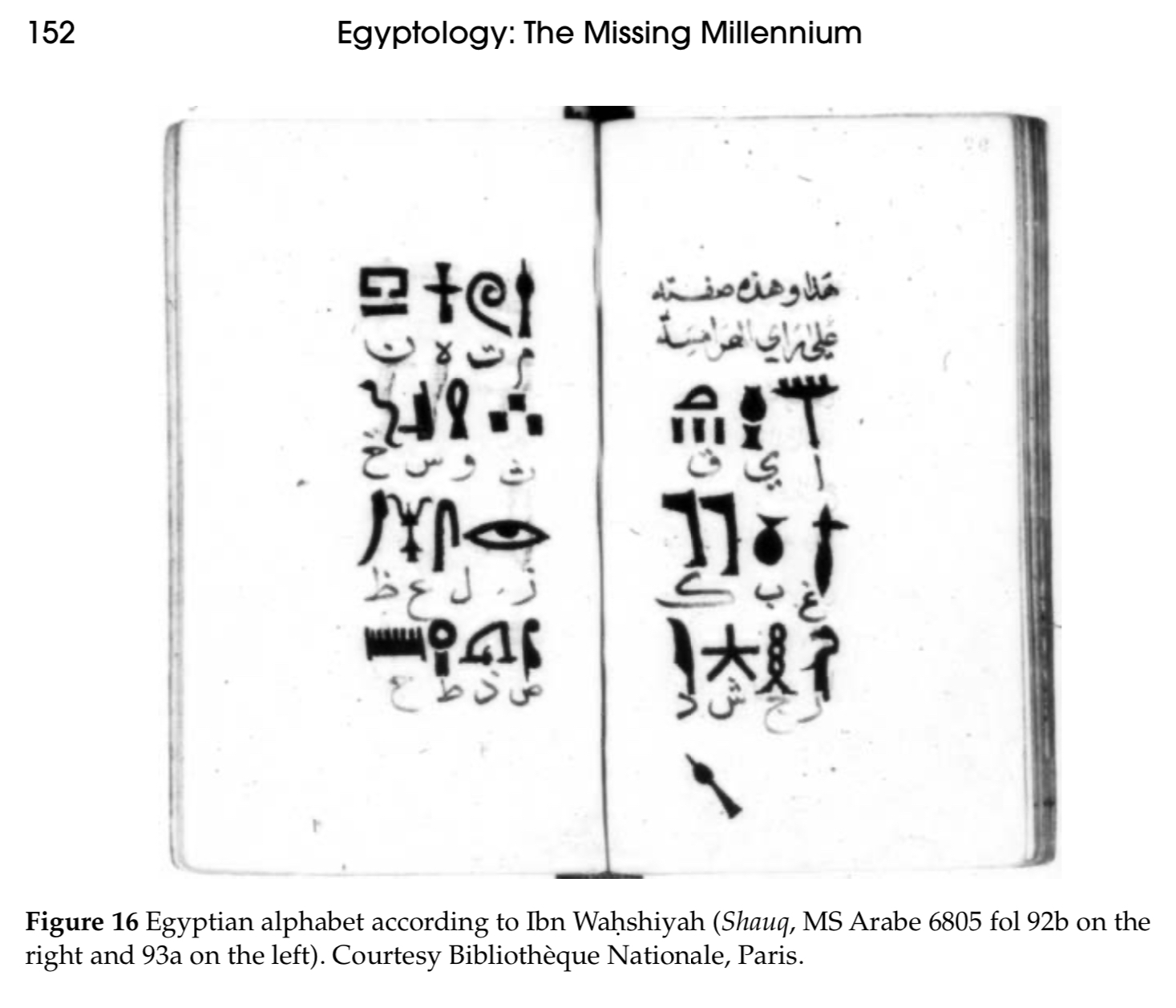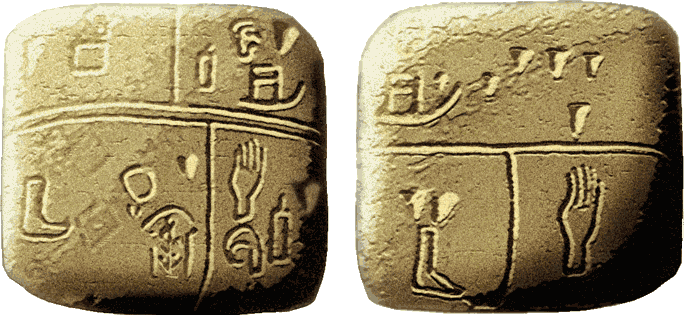Alphabet
As the Sumerian and Egyptian early dynasties share common origins, the writing system initially looked rather similar:
Kish tablet 3500 BC
The development of scripts is closely linked with the "secondary products" revolution: wool, clothing, metals, honey, bread, oil, beer, textiles, garments, rope, mats, carpets, furniture, jewelry, tools, perfume—all of these things and many more needed to be accounted for. The number of types of tokens in use ballooned to 250 by 3300 BCE.
Most alphabets of the world are derived from the Egyptian syllable-extended alphabet and/or the pure Ugaritic alphabet of 1400BC. The brilliance of the Egyptian alphabet is that they uses common Sumerian signs and applied them in a free standing, non determinant way.
Akkadian Greek Coptic Gothic alphabets show similar traces of silent components.
We mostly follow the conventional reading of the signs, with the exception of letter 'f' pth 𓆑 vs 𓇋e.
𓄿 𓂝 𓃀 𓍿 𓏏 𓂧 𓇋 𓇋 𓎼 𓉔 𓇋 𓆳 𓎡 𓐍 𓏯 𓅓 𓈖 𓏲 𓊪 𓏘 𓂋 𓍯 𓋴 𓏏 𓅱 𓅳 𓏴 𓏭 𓊃
The following are the most frequent signs of the hieroglyphics ordered by the modern roman alphabet. For the complete sign list see Gardinger signs. You can search and enter those signs with the online Dictionary/Keyboard
| letter | gard | sign | comment |
|---|---|---|---|
| A | 𓂝 | Arm | á 𒀉 PIE *h₂erm haraṇa (hand) A&O𓂣דראע𐤂 अस aṃs dharma etc |
| a | 𓄿 | Aar | Air al'pha𓃾 earn=eagle |
| b | 𓃀 | Bein | پَا 𒉽𒄬pap-half/pa-demi/ƥođ/ƥleɠ𓂾jambone𓄹𓄻 𓋁 𒁇bar/par 𒈦ban |
| c | 𓍿 | Ceh Z𓊃S𓋴 | ⵛappa𓏘𓎡𓍿 TS/ST ⵛ toe Tau? 𒄑 |
| D | 𓏏 | Delle/Tell | 𓏏𓏏dad=tit 𓂧δeirm𓂝 𒆕DU=do,build |
| D | 𓂧 | Daum | Ⲇ/δr/cheir/χειρo 𓄛 dast@Pers 𒋰dab double |
| E | 𓇋 | fEather 𓏭 | fEδer leicht (V)ι,e,i,a,ey ו ee↔i |
| F | 𓇋 | Fieder𓆑 | 𓇏fen 𓇌Viper phython=PhSn=:ϝn φϑظ |
| G | 𓎼 | Ɠiebel𓏘 | Kübel piK γ,κ,Γ,g,χ 𓌨𓊖𒆸Gur 𒂷ĝa Korb |
| H | 𓉔 | HOuse | Hair𓎛𓍢𓏲 Hundreh𓅱𓏲=100 hE𒂍 |
| I | 𓇋 | fIeder | 𓏤 (V)ι,e,a,ey,𓇌,ee=i,y |
| J | 𓆳 | 𓇋𓇋 | Jahr𓇺year 𓆓dj Ja?𓆶𓆴 Jana |
| K | 𓎡 | Kelle | 𓆼 kilo k-l-l=𓎟 𓎡𓎡𓇰 |
| Kr | 𓐍 | Kreis | gray𓊖kur/gyr𓌨*kar𓂓 |
| L | 𓏯 | Leo𓃭 | 𓈖𓇋𓇋𓌴 yλ niL 𓂅𓍢 𓂢Elle 𓌳ל¬laMed 𓂋 𓋴𓆓𓄓 𓄿lark |
| M | 𓅓 | Musen𒈪 | 𓏇𓇋𓅱𓃠mµnνuvw𐀖 Mut:𓂋𓅱𓅐𓀁 𓈗𓏠 |
| N | 𓈖 | NiL𓌳 | NAUtik 𓈖𓏤=𒈾 NAr.mer 𓈗mnuwave μν |
| O | 𓍯 | όριο | rho ϱ 𓍯rogue 𓂣A&O𓂝 o < p𓊪/k口/m𓂋/r𓂋/w𓊪/wh𓏲/h𓉔 |
| Po | 𓊪 | pad𐦈/pool | who𓊪𓏲 𒉺𐠞匹pǐ πⲠב𐀡𐠡Ⳁϱρрro pan ἀπο |
| Q | 𓏘 | Quarꜩ | 𓈎𓏇𓇋𓇋 Gummi 𓌽𓂋Gersten Korn 𓎡⋍q 𓎼𓐎𓁷𐀣 |
| R | 𓂋 | eaR | ohR àr arse ϱρрrot=Mund@Rus 𓏲round roài® 𓂌𓂍rayns الفم |
| R | 𓍢𓏲ϱ | 𓍯𓍢𓏲 | rogue rhound⋍100 |
| S | 𓋴 | 𓏏𓆓 | S'S C'S ß Γ ʃ δ 𓏏 Ⲋ𓆓 Shad𓈙Sea |
| T | 𓏏 | Teig | Dough 𓏏𓏏TiT tick𓏴tag𓏵Tag 𓏏th⋍s 𓍔 𓍘 𓄜𓄛 |
| U | 𓅱 | 𓍢𓏲 | HUhndert=100 𓏌Ων ωuν 𓏲𓍢وقف𐀸 wound |
| V | 𓇋 | viehder𓇋𓇋vaw | vyλ 𓅡phauw ννν:fun 𓄲 𓇋𓇋 va𓇋 |
| W | 𓅳 | uu𓏲𓍢 | ων waw 𓍢rwound 𐀸 𓎛wHr wΩm -mos µhwn𓅱 𓅓µwū乌 𓍢𓏲ϱr |
| X | 𓏴 | 𓏵 | 𐄂χX 𐠷=CS 𓎡𓋴 𓍲𓏴 ticks✓ 𓂧[end] Ξξ |
| Y | 𓏭 | ¨𓏮 𓇌 𓇋𓇋 𓆄𓆄 | vyλ丫yā:fork yuvw T+𓏮=TWO亚 义羽Yǔstice 𐀂Y 𓎡yek/juɠ |
| Z | 𓊃 | Zone | zusam syn 𓍿,ʒ,Z,Σ,ß,ss,ts,c,δ 𓄑 |
| Sh | 𓈉 | Schanze | 山ШшЩщ 𓆷swampϢ ∑ 三 sān Karδan 𓂓𓈋𓈙 |
This list is obviously a modern arrangement, what constitues a letter in the Egyptian Alphabet was not as clear cut: Many signs for prefixes, infixes, and suffixes had phonetic values. Determinants could appear in different places with often unknown influence on the phonetics of the word.
Signs which appear in different positions, or are used clearly phonetically: 𓌴 𓌳 𓍱 𓇥 𓌨 𓅮 𓅯 𓐠 𓆼 𓏌 𓁶 𓁷 𓂾 𓆄 𓐝 𓐛 𓐙 𓈅 𓇉 𓍑 𓐟 𓄡 𓅠! 𓏶 𓁹 𓌕 𓏇 𓐪 𓂞 𓌗 𓇿 𓄫 𓇑 𓍇 𓌰 𓈟 𓆷 𓍔 𓍘 𓍃 𓉻 𓂸 𓆰 𓌈 𓄖 𓂓 𓌘 𓌟 𓇐
Few of these would be counted towards an alphabet proper. Arguably only 𓌳 𓐝 … ?
Special: 𓈇 𓏤 𓏮 𓏥 𓏛 …
Many signs appear only or mostly in clusters (reminiscent of x ≈ ks, german "pf" "sch" … ) : 𓃀 𓅡 𓈖 𓅘 𓈖 𓌰 𓅓 𓌢 𓈖 𓃹 𓈖 𓄚 𓈖 𓏠 𓈖 𓇋 𓆛 𓈖 𓊃 𓆛 𓈖 𓎛 𓆰 𓈖 𓏅 𓈖 𓏏 𓅨 𓂋 𓇥 𓂋 𓈖 𓄓 𓎡 𓊃 𓅭 ( but many other contexts!) 𓆎 𓅓 ( but abbreviated as 𓆎 𓏛, 𓆎 𓏏 𓏌 𓏤, 𓆎 𓏏 𓊖)
Only prefix / suffix ( but with vastly different semantics ) : 𓐎 𓐡
Rare infixes 𓆱 :
Rare infixes can hint at etymological word boundaries:
𓈖 𓆱 𓐍 𓏏 𓂡 | victory| nike.toir @ greek
see π forms
The coherence of signs, meaning and 'cognate' sounds is striking, but if nothing else these are excelent mnemonics.
Each and every letter of this alphabet had an enormous influence on neighbouring countries and cultures.
In fact around the time of the Bronze Age collapse ⋍1200BC the convergence with Akkadian and Ugaritic cuneiform becomes noticeable, especially Ugaritic looks almost like the Phoenician alphabet put into stone.
Even in its early form, the Egyptian hieroglyphics system was 'almost alphabetic'. A quite small and easy to learn system of syllables, at least compared to Chinese.
The exact phonetic values are impossible to reconstruct, but comparative linguistics can give estimates for the dominant dialects. Even at the time when this language was still spoken most letters were clusters of similar sounds (see different values of 'a' in 'man','made','master',…)
For example many Egyptian words which have the character '𓃀' now have a 'b' in its derived coptic forms, or similar bh,ph,p,v,f sounds in modern variants of the word '𓃀' (all meaning ⋍leg)
Likewise 𓏏 blurred into a spectrum from D, DT, DH, T, TH, S
There is a huge cluster of hundreds of derive related words in many languages (pedestrian,𐀴 𐀪 𐀷 𐀆 (ti-ri-po-de = tripod Linear A), …,)
Dr. Christian De Vartavan did fantastic work reconstructing the pronunciation of the late stage of Egyptian. We take a somewhat different approach and try to reconstruct the early/middle forms of the signs when they were optionally readable as Complete Words, before they were reduced to syllables and phonemes.
It is admitted and obvious that the consensus mechanism went a bit too far: many words in dictionaries are reduced to the common denominator and just sequences of vowels a-a-a, etc. Thus while it is custom to treat determinants as silent signs, we treat them mostly as voiced infixes / suffixes.
A modern pendant would be:
New York 𓊖𓏏𓏤
New York City
In some cases both approaches seem legitimate, in others it seems more natural to include the suffix:
Through contract with demotic priests, medieval Arabian scholars Al-Idrisi (Anwar: 100f) and Al-Qalqashandi (Subh 3: 20) knew that the ancient Egyptians, whom they call al-qibt al-awal, had 32 to 36 letters in their alphabet. They both referred also to the fact that Coptic was linked to the ancient Egyptian language by calling the latter al-qibitiyah al-ula (the First Coptic). Source: ancient-egypt-in-medieval-arabic-writings
Signs which appear outside their deterministic context and are thus used as letters or syllables are listed in the extended alphabet.
The use of the Egyptian extended alphabet surely led to shifts in the spoken languages via phenomena such as https://en.m.wikipedia.org/wiki/Spelling_pronunciation
Recent research shows that knowledge of the Egyptian alphabet and its phonetic values was never completely lost and European scholars in the 19ths century might have drawn on Arabian sources:
See Subtleties for series of ever so slightly different signs.

Home | Alphabet | Grammar | Gardiner-signs
Home
preserved words
PIE
Inventions
Kur
Signs
Keyboard
Dictionary
Swadesh lists
Text Corpus
Axioms
Grammar
Pronouns
Numbers
Highlights
Cosmos
Gothic
Akkadian
determinatives
+
| äЯ | 𓄿 |
|---|---|
| A | 𓂝 |
| b | 𓃀 |
| c | 𓍿 |
| D | 𓏏 |
| δ | 𓂧 |
| E | 𓇋 |
| F | 𓇋𓆑 |
| G | 𓎼𓐍 |
| h | 𓉔 |
| I | 𓇋 |
| J | 𓆓 |
| K | 𓎡𓌨𓐍 |
| L | 𓏯𓃭 |
| M | 𓅓 |
| N | 𓈖 |
| ϱ | 𓍢𓍯 |
| P | 𓊪 |
| Q | 𓏘 |
| R | 𓂋 |
| S | 𓋴 |
| T | 𓏏 𓎀 |
| ṳ | 𓅱𓍢 |
| V | 𓆑 |
| W | 𓅳 |
| X | 𓎛 |
| Y | 𓏭 |
| Z | 𓊃 𓎀 |
| SH | 𓈙 |
